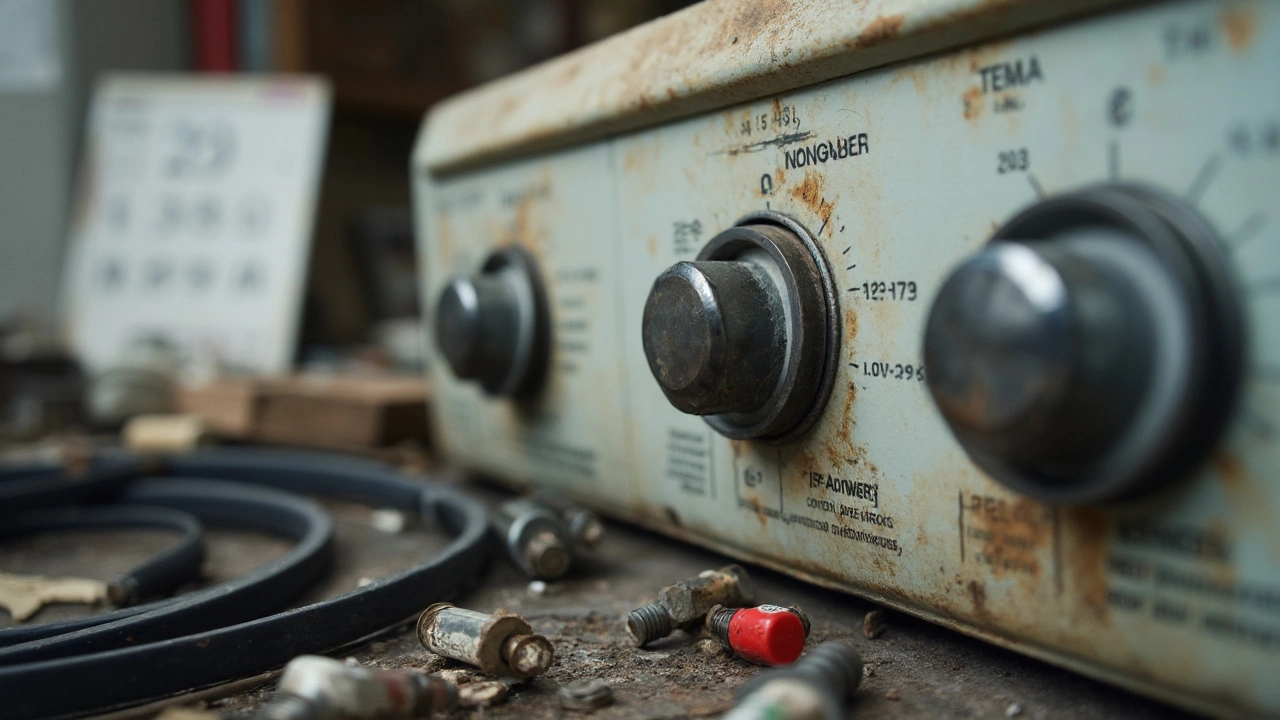That 10-year mark feels like a fork in the road for most dryers. When yours stops working or starts making weird noises, the question pops up: should you pour cash into fixing it, or start hunting for a new one?
Dryers are not built to last forever, but some can keep rolling for 12, even 15 years if you treat them right. Before you make a decision, it’s smart to check what actually went wrong. Sometimes it’s a worn-out belt, lint buildup, or a busted heating element—that stuff might cost less than your monthly streaming service. Other times, it’s a bigger headache, like the motor dying or the control board giving up, which can almost hit replacement-level money.
It’s tempting to just call a technician, but knowing a little about how long these machines last and what repairs usually cost can save you a ton of stress and cash. That’s what we’re diving into—so you get the facts you need, without the guesswork.
- How Long Do Dryers Really Last?
- Biggest Reasons Dryers Break After 10 Years
- Crunching the Numbers: Repair Costs vs. Replacement
- When a Repair Makes Sense (And When It Doesn’t)
- Pro Tips to Make Your Dryer Last Longer
How Long Do Dryers Really Last?
If you bought your dryer a decade ago and it’s still humming, you’ve definitely squeezed out some solid years. In the appliance world, that’s pretty good mileage. Most big brands say dryers should last anywhere from 10 to 13 years. If you stay on top of cleaning the lint filter and vent, and don’t overload it every week, you might even get a few extra years for free.
The U.S. Department of Energy points out that the average tumble dryer lifespan lands right around 11 years. Not all dryers are built the same, but that’s a good target for most people. Some folks ride their machines for 15 years or more, while others notice big problems closer to year 8—usually thanks to skipped maintenance or heavy use.
“A well-maintained dryer should be expected to function efficiently for 10 to 13 years,” says Consumer Reports. “Once past the decade mark, efficiency and reliability can drop off sharply.”
Here’s what influences how long your dryer will run:
- Usage habits: If you do laundry every day, your dryer will naturally wear out quicker than if you only run it once a week.
- Maintenance: Cleaning the lint trap every load and clearing out the vent a couple times a year can add years to your machine’s life.
- Type of dryer: Gas dryers tend to outlast electric models by about a year or two, on average.
- Brand quality: Some brands just hold up better. For example, Whirlpool and Maytag often outlast off-label brands.
If your dryer’s been reliable until now, hitting 10 years isn’t necessarily time to panic. But once repairs pile up or clothes start coming out damp, that’s usually the sign things are winding down.
Biggest Reasons Dryers Break After 10 Years
Hit the decade mark and most dryers start showing their age for a few pretty common reasons. Not all problems mean your dryer’s done for, but some are worth knowing about before you decide if that old workhorse gets another chance.
- Tumble dryer repair calls often start with a burned-out heating element. After years of cooking clothes, these coils just wear down or get caked with lint. No heat? This is your first suspect.
- Belts snap. The rubber belt that spins your drum doesn’t last forever. Ten years of use—add a couple heavy loads here and there—and that belt can crack or break. Easy fix, but annoying if you’re not ready for it.
- Motors wear down. The dryer motor is a tough little engine, but a decade’s worth of cycles takes its toll. A busted or noisy motor is pricey to fix and sometimes not worth the hassle.
- Control boards fail. Any electronics in older dryers, from timers to digital displays, can short out after years of vibration and heat. Once these go bad, repairs aren’t usually cheap.
- Thermal fuses blow. Safety fuses pop if your dryer overheats—which happens a lot if lint builds up in vents. Sometimes you just blow the fuse, but repeated issues spell bigger problems.
Here’s a quick look at what usually goes wrong after 10 years, how often, and about how much repairs can run you:
| Common Problem | Average Frequency (after 10 yrs) | Typical Repair Cost (USD) |
|---|---|---|
| Heating Element Burnout | High | $120-$250 |
| Belt Replacement | Medium | $100-$170 |
| Motor Failure | Medium | $250-$400 |
| Control Board Issues | Low-Medium | $180-$350 |
| Thermal Fuse Blown | Medium | $80-$120 |
One more thing—dust, lint, and pet hair really speed up a dryer's decline. Lint traps and vents that never get cleaned force the machine to work harder, so it breaks down faster and runs up your electric bill. Sticking to a yearly clean-out routine can make a bigger difference than most folks realize.

Crunching the Numbers: Repair Costs vs. Replacement
Let’s get down to business. Fixing a 10-year-old dryer isn’t always cheap, but replacing it can hit your wallet even harder. So, how do you know which option makes more sense?
If your basic problem is something like a broken belt or a busted thermostat, you might spend $50–$150 in parts and labor. But if your dryer’s motor or control board needs swapping, that can jump to $250 or more, and suddenly, buying a new one starts sounding like a good idea.
Here’s a quick look at common repair costs versus a fresh purchase:
| Repair/Replacement | Typical Cost (USD) |
|---|---|
| Heating Element | $100 – $200 |
| Drive Belt | $80 – $150 |
| Drum Roller | $70 – $130 |
| Control Board | $200 – $350 |
| Motor | $250 – $400 |
| Tumble dryer repair (average total) | $150 – $300 |
| Brand New Dryer | $400 – $1,000+ |
Ready for the rule of thumb? If a single repair is going to cost you more than half the price of a basic new dryer, don’t even bother—put your money towards a replacement. Also, consider what you actually get with a new machine: modern energy savings, better safety, maybe even a quieter laundry room.
- If you’ve already sunk cash into 2–3 repairs in the past year, don’t keep throwing good money after bad.
- Warranties end after around 10 years, so anything you fix is out of pocket.
- Older dryers usually use more electricity, which can mean higher ongoing costs even if you patch them up now.
Check how much life is left by thinking about usage. If you run big loads multiple times a week, you’re closer to the end of the road than someone who dries towels once every Sunday.
When a Repair Makes Sense (And When It Doesn’t)
Here’s the deal: Not every 10-year-old dryer is headed for the scrap heap. Fixing your machine can still make sense, but only in the right situation. It all comes down to the type of problem, the cost of the fix, and how your dryer stacks up against new models.
If the issue is small, like a busted belt, blown fuse, or a worn drum roller, you can get away with spending $100 or less—sometimes just the cost of the part and a YouTube video. Even swapping out a heating element or thermal fuse is usually worth it, since those repairs rarely top $200 with labor.
On the other hand, big-ticket repairs aren’t a smart bet for old appliances. Replacing the motor or control board? Now we’re talking $250 to $400, and suddenly, you're halfway to the price of a totally new machine.
| Typical Repair | Avg. Cost (USD) |
|---|---|
| Belt replacement | $80-$120 |
| Thermal fuse | $70-$130 |
| Heating element | $120-$220 |
| Motor replacement | $250-$400 |
| Control board | $300-$450 |
Another big factor is how efficient and reliable your current dryer is compared to what’s on the market. Newer models are more energy efficient, run quieter, and some even come with fancy moisture sensors that stop over-drying (which saves clothes and cash). And brands matter—a 10-year-old high-end dryer might outlast a budget machine by years, so check your make and model before giving up on repairs.
- If total repair cost is less than half the price of a new tumble dryer repair, fixing is usually the smart move.
- If you’ve already had multiple repairs in the past year, it’s probably time to cut your losses.
- If your dryer has major rust, bad drum damage, or you notice a burning smell, replacement is usually safer and cheaper in the long run.
Don’t forget to factor in your repair technician’s warranty—most decent services offer a 3-12 month guarantee, so you’re covered if something else breaks soon after. When in doubt, ask for a clear repair estimate and compare it to the cost of a modest new machine (which usually runs $500-$800 these days).

Pro Tips to Make Your Dryer Last Longer
If you’re hoping to squeeze more years out of your trusty dryer, a few simple habits can make a massive difference. Most breakdowns happen because of skipped maintenance or overloading. Here’s what actually works to keep your machine in top shape.
- Tumble dryer repair pros always say: clean the lint filter after every single load. Lint is the enemy—too much buildup makes your dryer work harder and can even cause fires. That’s not just talk; clogged filters are the #1 reason for reduced dryer efficiency.
- Don’t ignore the vent hose. Once a year, unplug the dryer and pull the vent hose off. Lint and dust get stuck in there. Use a vent brush or even your vacuum’s hose attachment to clear it out. Less clogged airflow means your dryer stays cooler and lasts longer.
- Skip the mega loads. Jamming the drum full might save you time, but it strains the motor and the belt, which can snap early. A good rule: fill the drum no more than three-quarters full.
- Level it up. A wobbly dryer rattles apart over time. Use a basic level to check—adjust the feet until it sits solid on the floor. Smoother spins, less wear, fewer repairs.
- Watch out for strange sounds. Thumping, screeching, or burning smells mean trouble. If you catch problems early, fixes are usually simple and way cheaper.
If you’re curious how these small fixes stack up against just winging it, check this table:
| Action | Potential Life Extension | Average Annual Repair Costs Saved |
|---|---|---|
| Regular lint filter + vent cleaning | +2-3 years | $70-150 |
| Avoiding overloading | +1 year | $40-80 |
| Early problem spotting | +1 year | $60-120 |
Most dryers start showing their age around the 8-year mark, but with these habits, reaching 12 years (or even more) is totally doable. Small routines, big savings, less hassle down the road.


